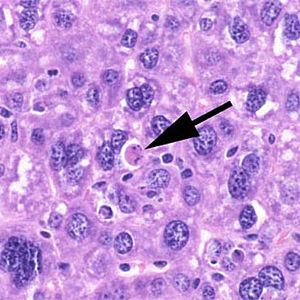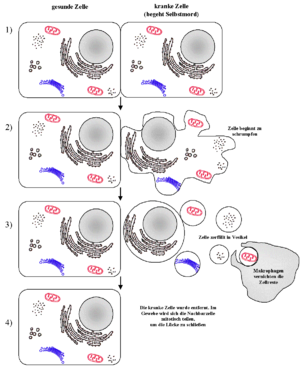Apoptosis
Apoptosis (Ancient Greek ἀπόπτωσις apóptosis, from ἀποπίπτειν apopíptein 'to fall off') is a form of programmed cell death. It is a 'suicide program' of individual biological cells. This can be externally stimulated (such as by immune cells) or triggered due to processes internal to the cell (such as after severe damage to genetic information). In contrast to the other important mechanism of cell death, necrosis, apoptosis is actively carried out by the cell itself and is thus part of the cell's metabolism. As a result, this form of cell death is subject to strict control and it is ensured that the cell in question perishes without damaging the neighbouring tissue.
In contrast to the other forms of programmed cell death, proteolytic enzymes known as caspases play a central role in apoptosis.
Apoptosis and necrosis can usually be easily distinguished visually: While apoptosis involves shrinkage of the cell and degradation of DNA by endonucleases into defined pieces (known as DNA laddering and detectable by electrophoresis and the so-called TUNEL method), necrosis involves swelling of the cell and destruction of its plasma membrane. As a result, local inflammation occurs as cytoplasm and cell organelles are released into the extracellular space, which must be removed by macrophages (phagocytes). Compared to necrosis, apoptosis is the more common form of cell death. In certain cases, however, apoptosis and necrosis cannot be sharply separated. The transition between the two forms of cell death is then fluid and is called aponecrosis.
The German-Swiss naturalist Carl Vogt was the first to discover apoptosis in 1842 while studying the development of tadpoles of the common midwife toad. The great significance of this discovery was (only) recognized over 100 years later. In 1972, John F. R. Kerr, Andrew Wyllie and Alastair R. Currie of the University of Aberdeen coined the term 'apoptosis'.

1000x, Zeiss PlanNeovfluar DIC, apoptosis in epithelial cell

Apoptotic cell of a mouse liver

Schematic sequence of apoptosis
Occurrence
During the development of an organism, apoptosis is essential:
- during the metamorphosis from tadpole to frog or the degeneration of the skins between the fingers/toes (interdigital skins), cells are specifically stimulated to apoptosis
- through apoptotic cell death of the cells of the vitreous body and lens of the lens eye, the light transmission of the eye lens is achieved
- to ensure the correct "interconnection" of brain structures and individual nerve cells, up to half of all originally formed nerve cells die again before birth
But it is also essential in the adult organism:
- for checking the cell count and the size of tissues
- in the rejuvenation of tissues (e.g. in the olfactory epithelium of the nose)
- in the selection and degradation of unnecessary or potentially harmful cells of the immune system
- for the elimination of degenerated cells
- to ensure plasticity in the central nervous system
- for the selection of germ cells (approx. 95 percent of germ cells are apoptotically killed before reaching maturity)
- in holocrine secretion, i.e. in the sebaceous glands of the human body
Currently, apoptosis is being researched particularly in connection with carcinogenesis and various autoimmune diseases. One goal of cancer research is to trigger controlled apoptosis in degenerated cells. However, cancer cells also use the apoptosis mechanism to switch off human defence cells, so-called tumour-infiltrating lymphocytes (TILs). Thus, an apoptosis-inducing protein, the CD95 ligand (Fas ligand), is found on the surface of various tumor cell lines. This mechanism is known as tumor counterattack.
The role of apoptosis in neurodegenerative diseases (e.g. Alzheimer's disease, Huntington's disease, Parkinson's disease, ALS) is also the subject of intense debate and a wide range of research is ongoing in this area.
Signs of apoptosis have also been found in unicellular organisms. In Saccharomyces cerevisiae (baker's yeast, brewer's yeast) - especially in old cells - various markers of apoptosis (DAPI, TUNEL staining) become visible. There is speculation about evolutionary reasons for the presence of apoptosis in unicellular organisms. One theory is that individual damaged cells sacrifice themselves and commit "suicide" for the good of the collective. This saves nutrients, which are thus available to the other cells. The goal is ultimately to preserve the genome, which is also present in virtually identical form in the other cells.
View
Histology
The process of apoptosis can be observed under the light microscope. First, the cell in question detaches itself from the tissue. In the further course, the cell becomes more and more eosinophilic in colour and becomes increasingly smaller. In addition, visible vesicles form on the cell membrane. The cell nucleus becomes smaller and more densely packed. In the course of apoptosis, it can also disintegrate into several parts. At the end of the process, a homogeneous eosinophilic apoptotic corpuscle remains. This is then degraded by phagocytosis. The programmed cell death does not trigger an inflammatory reaction.
Imaging techniques
Apoptosis can be detected macroscopically in vivo by imaging techniques such as positron emission tomography, fluorescence imaging and magnetic resonance imaging (molecular imaging). Modified amino acids, such as (5-dimethylamino)-1-napththalinsulfonyl-α-ethyl-fluoroalanine (NST-732) or N,N′-didansyl-L-cystine, are used as tracers.
Questions and Answers
Q: What is apoptosis?
A: Apoptosis is the controlled death of a cell.
Q: What role does apoptosis play in tissue development?
A: Apoptosis plays an important role in tissue development, such as allowing digits to separate from each other during limb development in a foetus.
Q: When does apoptosis occur most often?
A: Apoptosis occurs most often until puberty begins.
Q: Is apoptosis a regulated process?
A: Yes, apoptosis is a regulated and controlled process which works throughout an organism's life cycle.
Q: How is the rate of apoptosis balanced?
A: The rate of apoptosis is balanced by the rate of cell production by mitosis.
Q: Does apoptosis happen only during certain stages of life?
A: No, apoptsis happens throughout an organism's life cycle.
Search within the encyclopedia